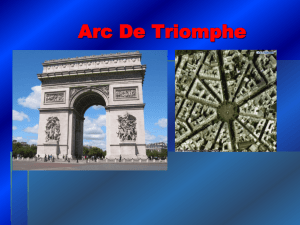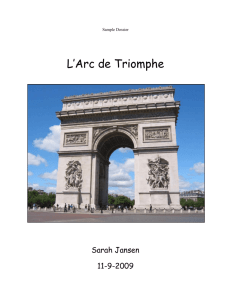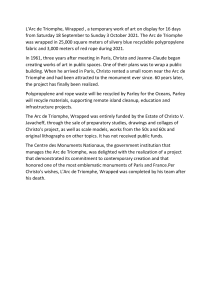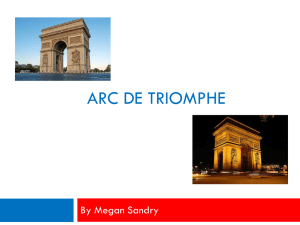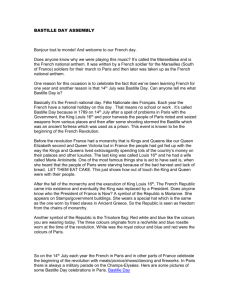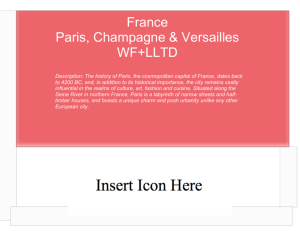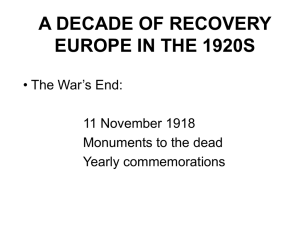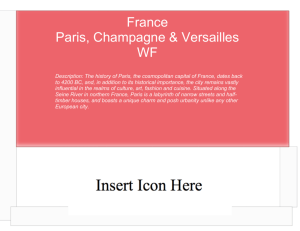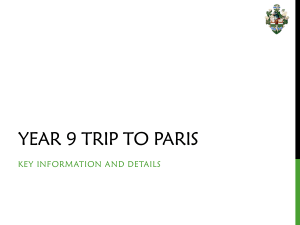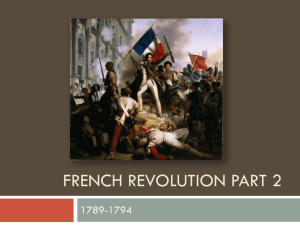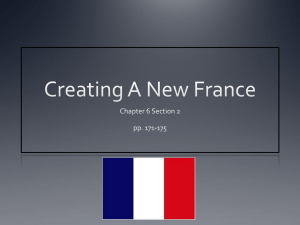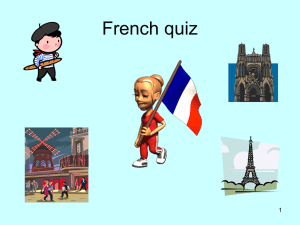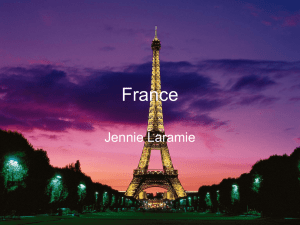Getting to know Paris
advertisement
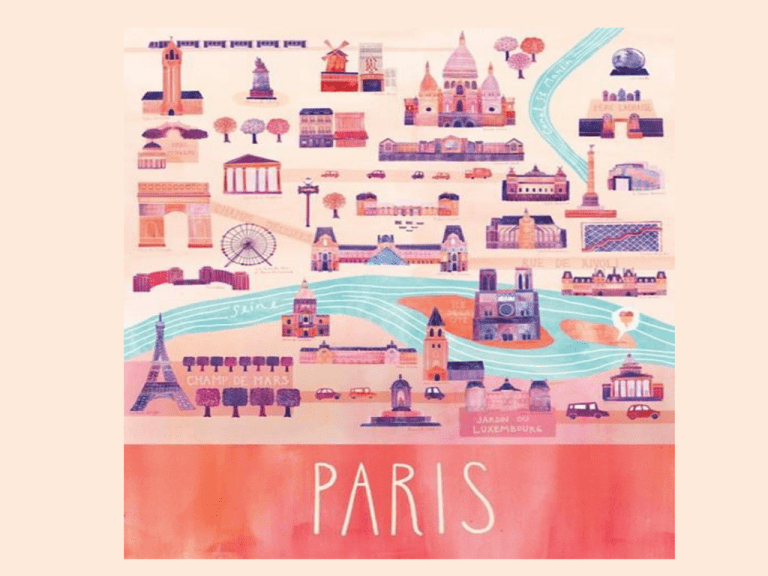
Paris is divided into 20 districts called arrondissements. They are arranged in the form of a snail. Six arrondissements are on the left bank of the Seine river. Fourteen are on the right bank. In the middle of La Seine are two islands: Île de la Cité and Île Saint-Louis. Le Métro The most used transportation by Parisians is the underground railway, also known as the Métro. There are 14 métro lines and 5 suburban train lines. There are over 300 métro stations in Paris. The metro was created in 1900 for the Exposition Universelle (World Fair). Most of the stations were designed by Hector Guimard in the style of Art Nouveau. Station Louvre-Rivoli was designed by the French artist Othoniel. Le vélib’ Parisians also use vélibs to travel around the city. They are free bicycles found throughout the entire city. Famous Landmarks La Tour Eiffel The Eiffel Tower was built in 1889 for l’Exposition Universelle (The World Fair) and was supposed to be dismantled at the end of the fair. The Eiffel Tower is 324 metres high. You can access the first and second levels by using the stairs or the elevators. You can access the third level only by using the elevator. From 6pm to 1am every night, the Eiffel Tower lights up and sparkles for 5 minutes Les Invalides A few minutes away from the Eiffel Tower is les Invalides. It was first constructed in 1670, as a home and hospital for aged and unwell soldiers. It now hosts the Army Museum . After leaving the Invalides and crossing the Seine river, you will find yourself on the Champs-Elysées. L’arc de Triomphe Napoléon ordered the conctruction of the Arc the Triomphe in 1808. The Arc the Triomphe is located on a roundabout – the biggest in the world – that opens onto twelve avenues. The Arc the Triomphe is located at the end of the Champs-Elysées, the most famous and most expensive avenue in Paris. The Arc de Triomphe was created to commemorate battles won by the French army. Under the arch lies the Tomb of the Unknown Soldier. La Concorde At the other end of the ChampsElysées, facing the Arc the Triomphe, stands la Place de la Concorde. It is the biggest square in Paris. The old Luxor Obelisk – an Egyptian construction 3300 years old – was transferred to Paris in 1836. It was offered to France by Egypt as a recognition of the work of Champollion, who was the first man to translate hieroglyphics. Le Louvre When you leave the Place de la Concorde, you enter the Tuileries garden that will lead you to the Louvre Museum. The Louvre was once the Palace of French Kings until Louis XIV moved to Versailles. The glass pyramid was completed in 1989. The most famous painting in the Louvre is La Joconde, also known as the Mona Lisa. It was painted between 1503 and 1505 by Leonardo Da Vinci. In reality, the rather small size of the painting always surprises the many tourists of the museum. On the contrary, the Musée de l’Orangerie hosts Les Nymphéas (the Waterlilies), a six-metre painting by the French artist Monet. Le Pont des arts To go from the Louvre to the left bank, you will need to cross Le Pont des Arts . On each side of the brigde, hundreds of locks have been placed. They are put here by couples who write their names on the locks and then throw away the key in the river as a sign of their undying Notre- Dame de Paris The Cathedral is located on an island on the Seine river and was used as the setting for the Disney movie The Hunchback of Notre-Dame. It took over two centuries to build Notre-Dame. On the forecourt of the cathedral is the Millenium point, also known as kilometre zero of French roads, that is still used today to calculate distances. Les gargouilles On top of Notre-Dame you will find the gargoyles. Their name comes from the Latin word for throat. were designed to They convey water away from the roof and the side of the building. Gargoyles were also built to scare the evil spirits away from the cathedral. Centre Pompidou The Centre Pompidou was completed in 1977 and is named after a former French president. It is the largest museum of modern art in Europe. The Place Georges Pompidou, in front of the centre is usually the scene of street performers such as mimes, jugglers, singers… The pipes The pipes on the outside of the building have a purpose. The blue pipes are the air conditioning ducts The green pipes convey water The yellow pipes convey electricity The red pipes are for the elevators. Fontaine Stravinsky Right next to the museum you will find the Stravinsky Fountain. It was created in 1983 by the artists Nikki de Saint Phalle and Jean Tinguely, and represent the work of the composer Igor Stravinsky Galeries Lafayette The Galeries Lafayette is the biggest department store in Paris. Each floor is dedicated to something different (cosmetics, shoes, apparel, accessories.) Every year for Christmas, a giant tree is set under the dome, and the exterior windows are a major attraction in the city. Moulin Rouge Le Moulin Rouge is the most famous cabaret in Paris. It was created in 1889. It is known as being the spiritual birthplace of can-can. It is located in Montmartre, home of main artists of the time. Toulouse-Lautrec was a famous regular customer of the cabaret. Le Sacré-Coeur Is a church that was built in 1870 and is at the top the hill of Montmartre. You can access the top of the hill by using the stairs or the Funiculaire (a little cablecar). Montmartre is famous for its narrow streets and its street painters. The hill was the home of painters like Toulouse-Lautrec, Modigliani, Picasso or Van Gogh. Bastille The Bastille was formally a fortress. For years, it was used as a prison by the kings of France. On the 14th July 1789, during the French Revolution, the townspeople broke in, freed the prisoners then completely demolished the prison. in 1899, the foundations of the Liberté Tower were uncovered and moved to the centre of the square where they can still be seen today. La Bastille became the symbol of French revolutions. Since 1790, La prise de la Bastille (the Storming of Bastille), is celebrated annually on the 14th July . Bastille Day, is the major French public holiday. Every year, there is a military parade from the Arc de Triomphe down the Champs Elysées, and there is a flyover with jet streams in blue, white and red. La Défense In eastern Paris is la Défense , the business district of the city. La Grande Arche (on the right) is the most iconic building of the district. Inside the tower are offices. Versailles The Palace of Versailles was the home of French kings and queens. In 1682, Louis XIV moved from the palace of the Louvre to Versailles to suit his dreams of grandeur. However in 1789, during the French revolution, the king, Louis XVI, his wife Marie Antoinette and their family had to move back to the city One of the most important features of the palace is the Gallery of Mirrors, where the king asked for everything to be covered in gold. The gardens of Versailles represent one of the finest example of jardin à la française. Versailles also features five chapels and the domain of the Queen called Le Trianon. Le Trianon is located opposite the palace and was the private domain of Marie Antoinette, where you can find her little palace, gardens à l’anglaise and a farm.
